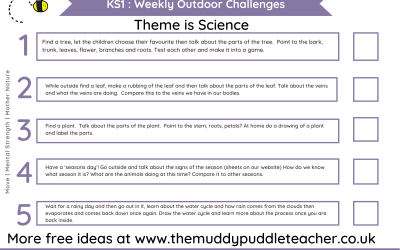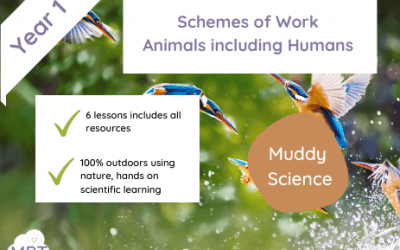Use Forest School Cooking Recipes - Open Fire/BBQ to get a list of our favourite recipes separated into outdoor...
Diagram of a Sunflower
Apr 11, 2021
Exploring Sunflowers: Teaching with Outdoor Activities Sunflowers are not only vibrant and beautiful but also offer a...
Sunflower Day Growth Chart – EYFS/KS1
Apr 11, 2021
EYFS/KS1 - Enjoy using this resource on Sunflower Day so that the children can record the height and observe their...
Muddy Science Day (Parent Letter)
Feb 27, 2021
Use Muddy Science Day (Parent Letter) to inform parents about this special day. Part of the children’s curriculum is...
*FREE*Signs of Autumn Explorer Sheet
Jan 27, 2021
Use the Signs of Autumn Explorer Sheet to get the children outside applying their Science and wonder of the world the...
*FREE* KS1 Weekly Outdoor Learning Challenges (Theme Science)
Jan 24, 2021
KS1 Weekly Outdoor Learning Challenges (Theme Science)
Signs of Spring Activity Sheet
Jan 22, 2021
Use the Signs of Spring Activity Sheet to get the children outside applying their Science and knowledge in an active...
Signs of Winter Activity Sheet
Jan 22, 2021
Use the Signs of Winter Activity Sheet to get the children outside applying their Science and knowledge in an active...
*FREE*Butterfly Spotter Activity Sheet
Jan 22, 2021
Use the Butterfly Spotter Activity Sheet to get the children outside applying their Science and knowledge in an active...
Lesson 1: Bird Spotter Activity Sheet
Jan 22, 2021
Use the Bird Spotter Activity Sheet to get the children outside applying their Science and knowledge in an active way....
Year 1 Animals Including Humans (Brilliant Birds)
Jan 19, 2021
Completely 100% outdoor scheme of work for Year 1 Animals Including Humans! Use Year 1 Animals Including Humans Scheme...
*FREE*Daily Outdoor Challenges KS1 – Nature Theme
Jan 18, 2021
Daily Outdoor Challenges KS1 Nature Theme Let the Muddy Puddle Teachers help you with the lockdown and get free whole...
Plants and Seasons (Year1) Science Unit – Outdoor Scheme of Work
Jan 7, 2021
Plants and Seasons (Year1) Science Unit - Scheme of Work This unit has been created so that you can observe plants,...
Identifying and Naming Plants
Jan 6, 2021
Identifying and Naming Plants. Subscribers add to cart then checkout for download. Identifying & Naming Plants...
Habitats
Dec 30, 2020
Use Habitats ideas pack to help you get your class hands-on with this area of Science this year. Teaching this kind...
Indoor Planting
Sep 17, 2020
Make planting a little easier for yourself by taking some of it indoors. This delightful pack offers ideas for vegtables, fruit, flowers and herbs.
30 Minute Bug Craft Ideas
Jul 23, 2020
30 mins Bug Craft Ideas
KS1 Welly Walks
Jul 23, 2020
Use Welly Walks for Muddy Infants to get more lesson out in your local area. Maybe have a Welly Wednesday or Muddy Monday. Full of ideas o get imaginations, Science and more outside while walking.
New In

Bug Outdoor Learning Scavenger Sheet

Outdoor Learning Activities for Nursery – Resource Pack

Outdoor Learning Safety Poster

Outdoor Learning Risk Assessments: (Handout)

Outdoor Learning Safety Advice (CPD Handout)

Outdoor Learning CPD Guidance (Handout )

Outdoor Learning Ideas for Schools: Engaging Ways to Teach Outside

Outdoor Multiplication Lesson Plans

World War One Lesson Plan




















